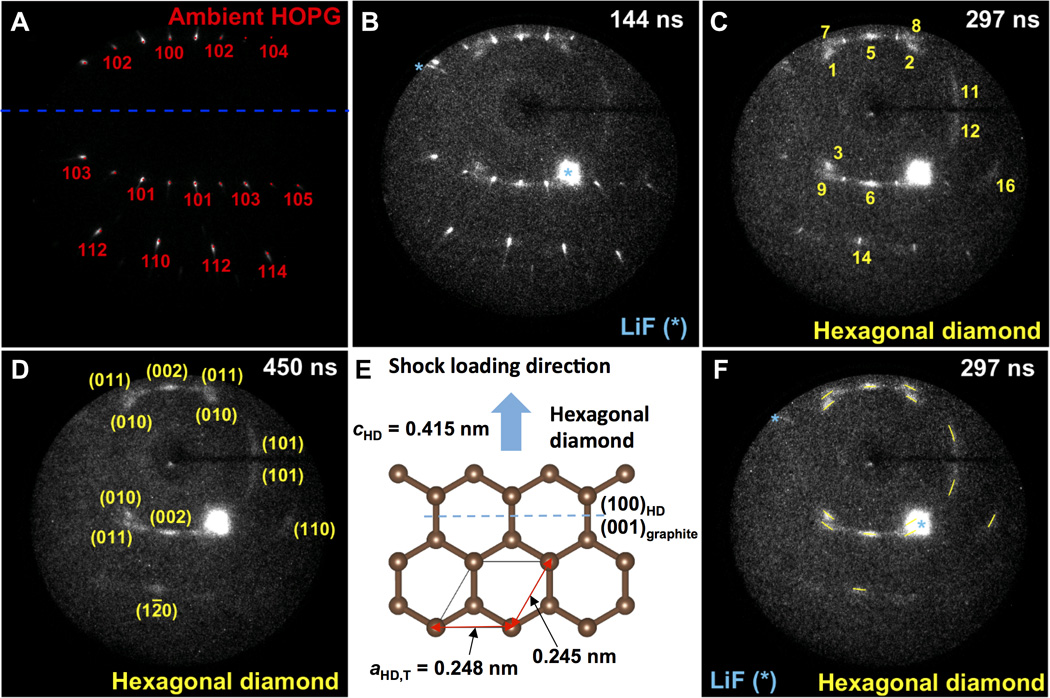The original Washington State University press release by Will Ferguson can be read here.
A new study by Washington State University (WSU) researchers using the U.S. Department of Energy’s Advanced Photon Source (APS) at Argonne National Laboratory answers longstanding questions about the formation of a rare type of diamond formed during major meteorite strikes. The discovery could help planetary scientists use the presence of hexagonal diamond at meteorite craters to estimate the severity of impacts.
Hexagonal diamond or lonsdaleite is harder than the type of diamond worn on an engagement ring and is thought to be naturally made when large, graphite-bearing meteorites slam into Earth. Scientists have puzzled over the exact pressure and other conditions needed to make hexagonal diamond since its discovery in an Arizona meteorite fragment half a century ago.
Now, a team of WSU researchers has for the first time observed and recorded the creation of hexagonal diamond in highly oriented pyrolytic graphite under shock compression, revealing crucial details about how it is formed. The research was possible because of an unprecedented experimental development — the WSU-led Dynamic Compression Sector (DCS), Sector 35 of the Argonne APS (the APS is an Office of Science user facility). The DCS is a first-of-its-kind experimental facility that links different shock wave compression capabilities to synchrotron x-rays. Using its unique capabilities, the WSU team was able to take x-ray snap shots of the transformation of graphite to hexagonal diamond in real-time.
The results of the researchers’ were recently published in the journal Science Advances.
“The transformation to hexagonal diamond occurs at a significantly lower stress than previously believed,” said WSU Regents Professor Yogendra Gupta, director of the Institute for Shock Physics and a co-author of the study. “This result has important implications regarding the estimates of thermodynamic conditions at the terrestrial sites of meteor impacts.”
WSU scientist Stefan Turneaure and a team of researchers found that the crystalline structure of a highly oriented form of graphite transforms to the uncommon hexagonal form of diamond at a pressure of 500,000 atmospheres, around four times lower than previous studies had indicated.
To obtain their results, the researchers shot a lithium fluoride impactor at 11,000 mph into a 2 mm thick graphite disk. They then used pulsed, high-brightness synchrotron x-rays from the APS and in situ x-ray diffraction to take snapshots every 150 billionths of a second, while the shockwave from the impact compressed the graphite sample. Their work unambiguously demonstrated that the graphite sample transformed into the hexagonal form of diamond before being obliterated into dust.
“Most past research relied on microstructural examination of samples after they were shock compressed to infer what might have happened,” Turneaure said. “Such late-time measurements do not tell the whole story of what happened to the material during shock compression.”
Turneaure and Gupta said the next step in the research will be to investigate under what conditions pure hexagonal diamond can be recovered after shock compression.
“Diamond is a material that is very easy to get excited about and our work in this area is just beginning,” Gupta said. “Moving forward, we plan to investigate the persistence of this form of diamond under lower pressure. Because it is thought to be 60 percent harder than the common cubic diamond, hexagonal diamond could have many potential uses in industry if it could be successfully recovered after shock compression.”
See: Stefan J. Turneaure, Surinder M. Sharma, Travis J. Volz, J. M. Winey, Yogendra M. Gupta*, “Transformation of shock-compressed graphite to hexagonal diamond in nanoseconds,” Sci. Adv. 2017;3: eaao3561 27 October 2017). DOI: 10.1126/sciadv.aao3561
Author affiliation: Washington State University
Correspondence: *ymgupta@wsu.edu
Y. Toyoda, P. Rigg, and the DCS staff are thanked for their assistance with the in situ XRD impact experiments. This publication is based on work supported by the U.S. Department of Energy (DOE)/National Nuclear Security Administration (NNSA) under award no. DE-NA0002007. This publication is also based on work performed at the DCS, which is operated by Washington State University under the DOE/NNSA award no. DE-NA0002442. This research used resources of the APS, a DOE Office of Science User Facility operated for the DOE Office of Science by Argonne National Laboratory under contract no. DE-AC02-06CH11357.
Argonne National Laboratory seeks solutions to pressing national problems in science and technology. The nation's first national laboratory, Argonne conducts leading-edge basic and applied scientific research in virtually every scientific discipline. Argonne researchers work closely with researchers from hundreds of companies, universities, and federal, state and municipal agencies to help them solve their specific problems, advance America's scientific leadership and prepare the nation for a better future. With employees from more than 60 nations, Argonne is managed by UChicago Argonne, LLC for the U.S. Department of Energy's Office of Science.
The U.S. Department of Energy's Office of Science is the single largest supporter of basic research in the physical sciences in the United States and is working to address some of the most pressing challenges of our time. For more information, visit the Office of Science website.

